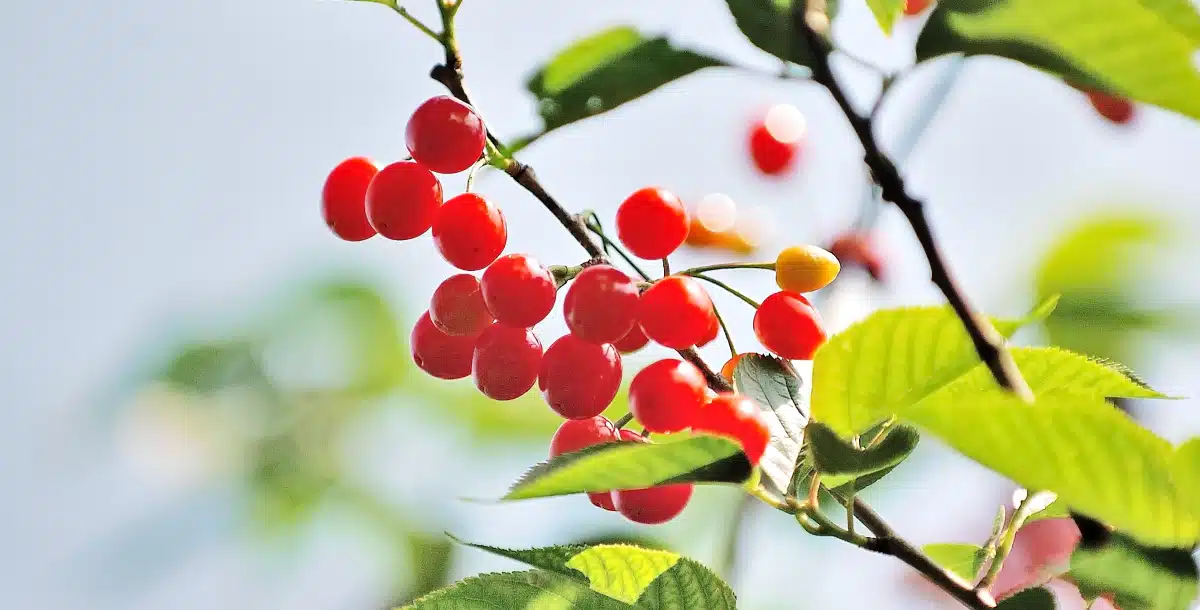Cherries, with their delightful flavor and rich nutritional content, are a favorite fruit for many. However, they also attract a variety of birds and pests. Additionally, severe weather conditions like hailstorms and heavy rain can significantly threaten cherry trees. These factors can impact the yield and quality of cherries, sometimes even leading to the loss of an entire season’s work. To mitigate these risks, cherry tree netting has become a popular protection method.
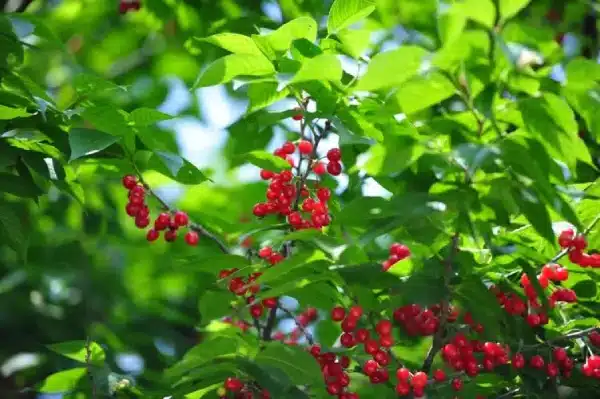
Ripen Cherries
Choosing and using cherry tree nets requires considering various factors, including the type of netting, the material used, durability, and how to select the right one for different growing environments. This article delves into cherry tree netting, from small-scale home gardens to large commercial orchards, providing comprehensive information to help you make informed choices when protecting your cherry trees.
How to Choose the Right Cherry Tree Netting
Cherry tree netting is mainly used to protect ripening cherries from external threats like birds and hail. There are various types of cherry tree netting on the market, and choosing the right one involves considering functionality, material, mesh size, and price. Here’s a guide on how to make an informed choice.
1. Functionality
The primary function of cherry tree netting is to prevent birds from eating ripe cherries. However, cherry trees can also face other environmental threats, especially during the spring and summer, like hailstorms. If you live in an area prone to hail, consider choosing hail-proof netting with smaller mesh sizes. This type of netting protects against birds and shields the trees and fruit from hail damage, providing more comprehensive protection.
2. Material
Cherry tree netting typically comes in three common materials: polypropylene, nylon, and polyethylene. Each material has unique advantages and disadvantages, so understanding their properties will help you select the best protection.
- Polypropylene is the lightest option, easy to install, and economical. Its recyclable nature makes it environmentally friendly. However, its durability is relatively low, especially in extreme weather conditions. This makes polypropylene suitable for short-term use in environments with lower durability requirements.
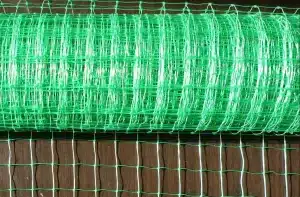
PP Square Bird Net
- Nylon is known for its toughness and elasticity. Nylon is significantly more durable than polypropylene, capable of withstanding higher pressure and tension, making it ideal for long-term use. Nylon is also more expensive and slightly heavier, requiring more labor during installation.
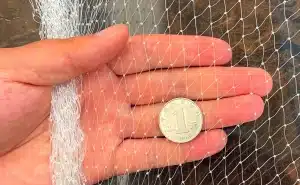
China-made nylon bird netting
- High-density polyethylene (HDPE) with added UV stabilizers is popular for its excellent waterproof and UV-resistant properties. This material is robust and highly durable, performing well in various climates. However, polyethylene is less elastic than nylon, which may impact its performance in strong winds and other dynamic environments. Polyethylene is best for high-strength and waterproof netting, especially in outdoor settings.
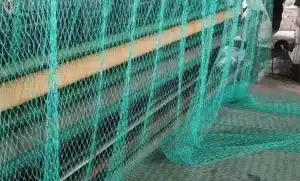
HDPE green bird netting
3. Mesh Size
Besides choosing the right material, mesh size is also a critical consideration for cherry tree netting. The mesh size directly affects the protective capability, especially in terms of preventing bird damage. Generally, cherry bird netting has mesh sizes ranging from 0.7 inches (about 2 cm) to 1.7 inches (about 4.5 cm). This range can effectively block most birds while ensuring sufficient sunlight and air circulation for cherry tree growth.
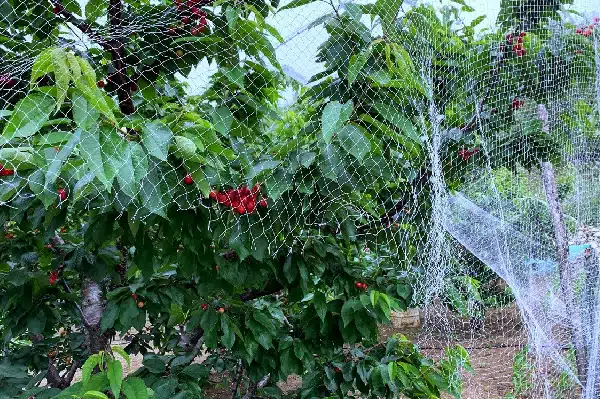
Cherry Tree Netting Mesh
Netting with smaller mesh sizes might be more suitable if you’re in an area prone to hail. Hail particles can be smaller than typical birds, so hail-proof netting with mesh sizes around 0.39 inches (about 1 cm) can offer better protection.
4. Price
The price of cherry netting varies based on material, size, and purchasing source. In retail, cherry bird and hail-proof netting typically range from $0.06 to $0.12 per square foot. Smaller mesh sizes generally come with a higher price. For large orchard owners, buying in bulk directly from global suppliers or manufacturers might be more economical, as this can offer better pricing.
Whether selecting suitable cherry netting for a few cherry trees in your garden or seeking the most effective solution for a large-scale cherry orchard, the key is choosing the netting that suits your needs. This ensures the best protection for your cherry trees while maximizing your return on investment.
How to Install Cherry Tree Netting for Home Use
If you have a few cherry trees in your yard and are looking for ways to protect them, you can find the suitable bird and hail-proof netting at your local gardening store or online retailers. There are some ideas on how to set up cherry netting for cherry trees in the garden.
1. For Small Cherry Trees
You can use bamboo poles or wooden sticks to support the netting for shorter cherry trees. First, insert several bamboo poles or sticks around the tree, ensuring they are slightly taller than the tree’s canopy. This will create a support frame, preventing the netting from touching the canopy and fruit.
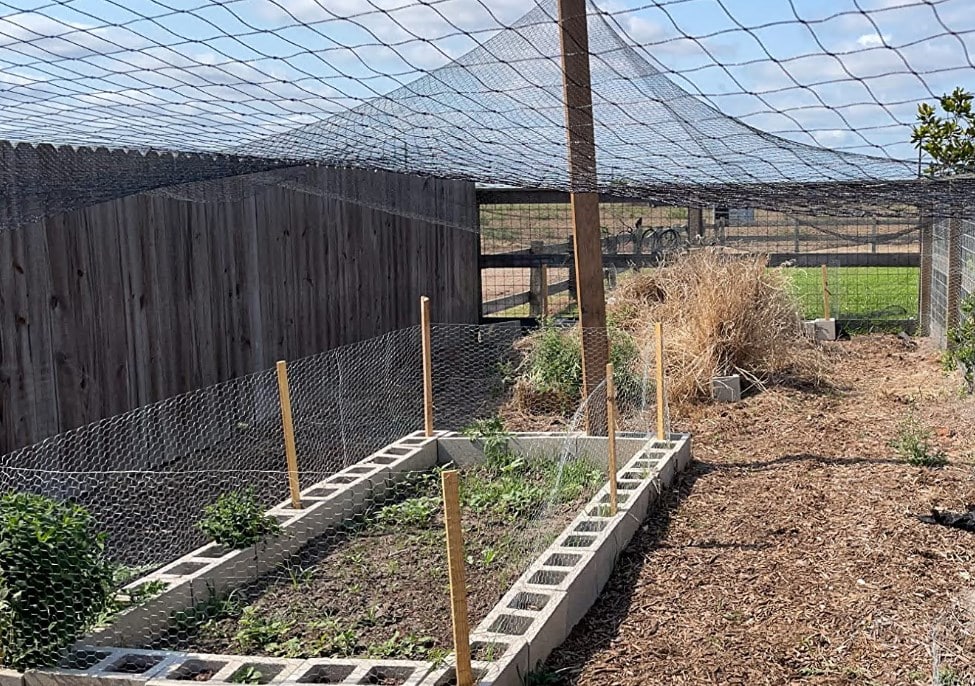
DIY Sturcture for Bird Nets
Next, gently drape the netting over the tree, pulling the edges to the ground. Secure the netting to the bamboo poles or sticks with zip ties or rope to ensure it doesn’t get blown away by the wind. This method is simple to execute, cost-effective, and suitable for home gardening.
2. For Large Cherry Trees
You’ll typically need a bigger net. You can directly drape the netting over the tree’s canopy and let it hang naturally to ensure complete coverage. At the base of the tree, gather the edges of the net and secure them with garden twine or other binding materials to the tree trunk.
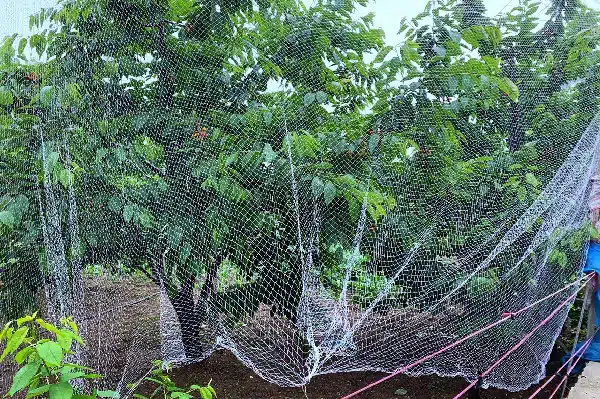
Cherry Tree Covered with Bird Netting
This way, the net encloses the entire cherry tree, providing comprehensive protection. To prevent birds and other animals from entering through the bottom of the net, ensure it touches the ground and use stones, sandbags, or other heavy objects to secure the base. This approach effectively protects larger cherry trees from birds, insects, or small animals.
3. Bonus Tip
Whichever method you choose, the key is to ensure the netting is secure and won’t blow away in the wind while considering proper ventilation and sunlight for the trees. You can purchase the necessary materials and tools from gardening supply stores for greater durability and reliability.
How to Install Cherry Tree Netting for Orchards
For cherry orchard owners, choosing the right netting method is crucial for protecting the fruit and increasing yield. Here are some different approaches and their advantages, suitable for orchards of various sizes and requirements.
1. Individual Tree Covering
In medium and small cherry orchards, individually covering each tree with netting is a customized approach that offers tailored protection. Though labor-intensive, this method is ideal for orchards with uniquely shaped or irregularly distributed trees. It allows you to adjust the netting to fit each tree’s specific size and shape, ensuring effective coverage without exposing any part.
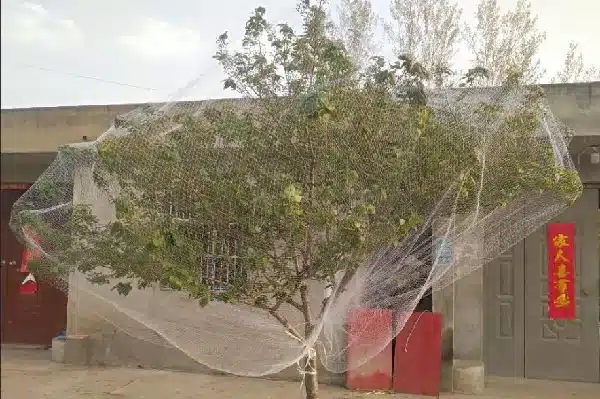
Individual Tree Covering
2. Draping Netting Along Rows
In orchards where trees are arranged in rows, you can drape netting along the entire row. This common and efficient method provides consistent coverage across multiple trees while allowing flexibility to ensure no gaps are exposed. It is a popular choice for protecting smaller orchards as it reduces installation complexity and labor requirements.
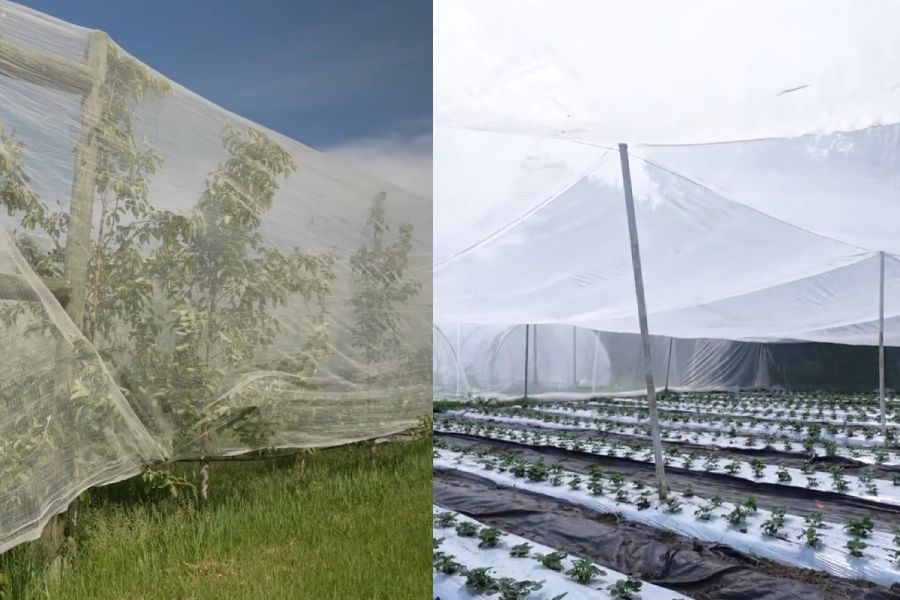
Draped netting vs overhead netting
3. Overall Netting Structures
For larger cherry orchards, an economical and efficient method is to cover entire rows with a frame and hang bird netting over it. This approach provides protection for multiple trees at once, with the frame slightly taller than the tallest tree canopy to prevent birds from landing on the net. Properly securing the netting at the bottom is crucial to prevent animals from entering from below.
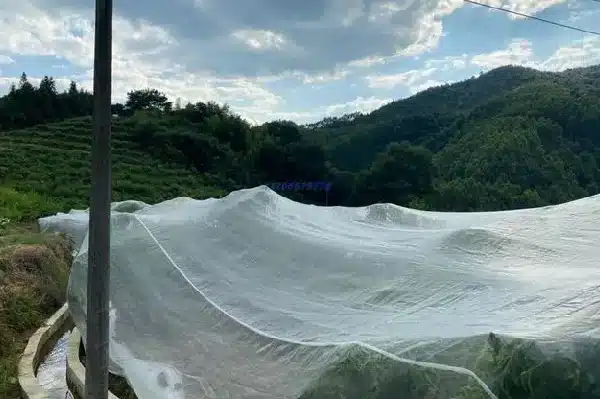
Overhead netting for cherry trees
4. Greenhouse-like Structures
Another effective option is to build a greenhouse-like arch structure and cover it with bird netting or hail netting. This structure can withstand strong winds, heavy rain, and hail, offering comprehensive and robust protection for cherry trees.
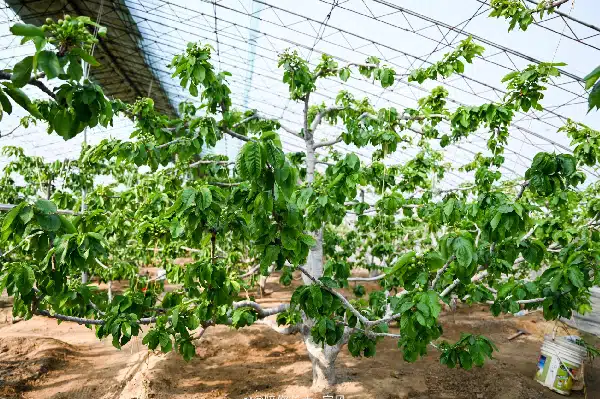
Greenhouse-like arch structure
It’s ideal for orchards in regions prone to severe weather or where durability is essential. This approach provides a stable environment for cherry trees while delivering high-level protection.
Frequently Asked Questions
Here are some common questions about cherry tree netting and their answers to help you install and manage your netting at the right time.
1. When is the Best Time to Install Cherry Tree Netting?
The best time to install cherry tree netting is before the cherries turn red. Sometimes, even before the cherries show the first hint of color, birds might be eyeing your fruit. As the cherries ripen, bird activity increases significantly. Installing cherry tree netting early can effectively prevent birds from reaching the fruit, reducing the risk of damage.
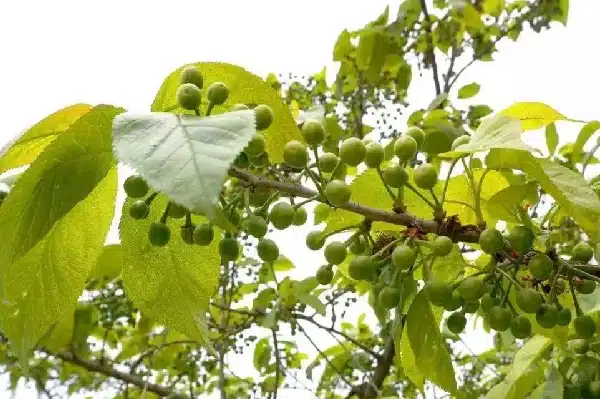
Unripe Cherries
2. Do I Need to Keep the Netting on All Season?
No! Installing the netting too early might interfere with pollination, leading to a drop in fruit yield. Additionally, growing cherry tree branches could pierce the net, causing damage. Therefore, it’s best to install the netting before the cherries mature and remove it before harvesting to avoid damaging the fruit and tree.
3. How Should I Store Cherry Tree Netting?
When storing cherry tree netting, make sure it’s cleaned and completely dried. You can gently rub it with detergent and clean water, fold it neatly and store it in a cool, dry place away from direct sunlight and high temperatures. Ensure no sharp objects are in the storage area to prevent the netting from getting damaged during storage. Proper storage ensures you can use the netting again for the next season.
Should I Prune the Branches Before Installing Cherry Tree Netting?
Yes! Pruning branches before installing cherry tree netting is essential. Pruning ensures the cherry trees remain at a suitable height for netting installation. It also allows more sunlight to penetrate the net, helping the entire tree breathe better, increasing cherry yield and quality, and ultimately boosting orchard productivity.
Conclusion
In this article, we’ve discussed the selection and use of cherry tree netting, covering its functionality, materials, mesh size, and price. We also provided installation methods for different planting scales. We hope these insights will help you in your cherry-growing endeavours. If you have any other questions about cherry tree netting or additional suggestions, feel free to leave a comment.
